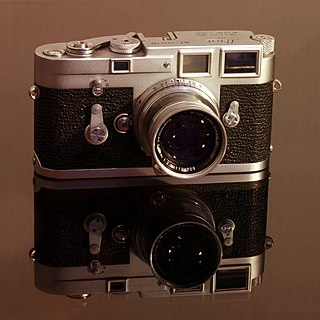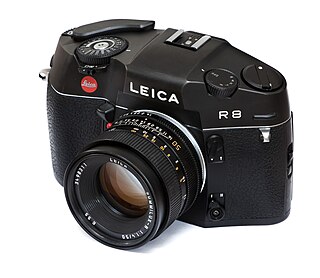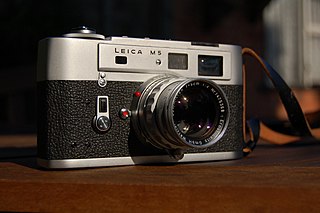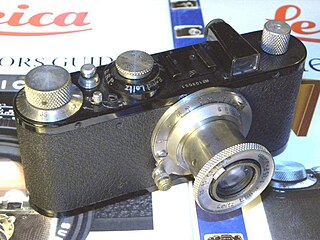
135 is photographic film in a film format used for still photography. It is a cartridge film with a film gauge of 35 mm (1.4 in), typically used for hand-held photography in 35 mm film cameras. Its engineering standard for the film is controlled by ISO 1007.

The Nikon F camera, introduced in April 1959, was Nikon's first SLR camera. It was one of the most advanced cameras of its day. Although many of the concepts had already been introduced elsewhere, it was revolutionary in that it was the first to combine them all in one camera. It was produced until October 1973 and was replaced by the Nikon F2. Aspects of its design remain in all of Nikon's subsequent SLR cameras, through the current Nikon F6 film and Nikon D5 digital models. The "F" in Nikon F was selected from the term "re-f-lex", since the pronunciation of the first letter "R" is not available in many Asian languages. That tradition was carried all the way through their top line of Nikon cameras until the introduction of the Nikon D1 (digital) cameras decades later.

Leica Camera AG is a German company that manufactures cameras, lenses, binoculars, rifle scopes, microscopes and ophthalmic lenses. The company was founded by Ernst Leitz in 1914. The name Leica is derived from the first three letters of his surname (Leitz) and the first two of the word camera: lei-ca.
Robot is a German imaging company known originally for clockwork cameras, later producing surveillance (Traffipax) and bank security cameras. Originally created in 1934 as a brand of Otto Berning and Co., it became part of the Jenoptik group of optical companies in 1999. In 2002 the company changed its name from Robot Foto & Electronic to ROBOT Visual Systems GmbH.

Zorki is the name of a series of 35mm rangefinder cameras manufactured in the Soviet Union between 1948 and 1978.

Minolta Co., Ltd. was a Japanese manufacturer of cameras, camera accessories, photocopiers, fax machines, and laser printers. Minolta was founded in Osaka, Japan, in 1928 as Nichi-Doku Shashinki Shōten. It is perhaps best known for making the first integrated autofocus 35 mm SLR camera system. In 1931, the company adopted its current name, an acronym for "Mechanism, Instruments, Optics, and Lenses by Tashima". In 1933, the brand name first appeared on a camera, a copy of the Plaubel Makina simply called "Minolta".

Contax began as a camera model in the Zeiss Ikon line in 1932, and later became a brand name. The early cameras were among the finest in the world, typically featuring high quality Zeiss interchangeable lenses. The final products under the Contax name were a line of 35 mm, medium format, and digital cameras engineered and manufactured by Kyocera, and featuring modern Zeiss optics. In 2005, Kyocera announced that it would no longer produce Contax cameras. The rights to the brand are currently part of Carl Zeiss AG, but no Contax cameras are currently in production, and the brand is considered dormant.

The Leica M3 is a 35 mm rangefinder camera by Ernst Leitz GmbH, introduced in 1954. It was a new starting point for Leitz, which until then had only produced screw-mount Leica cameras that were incremental improvements to its original Leica (Ur-Leica). The M3 introduced several features to the Leica, among them the combination of viewfinder and rangefinder in one bright window, like on the Contax II, a bayonet lens mount, and rapid film advance lever. It was the most successful model of the M series, with over 220,000 units sold by the time production of the M3 model ended in 1966.

The FED is a Soviet rangefinder camera, mass-produced from 1934 until around 1996, and also the name of the factory that made it.

The Leica M6 is a rangefinder camera manufactured by Leica from 1984 to 1998.

The Olympus OM-1 is a manually operated 35mm single-lens reflex camera. It is part of the Olympus OM system.

The Leica M8 is the first digital camera in the rangefinder M series introduced by Leica Camera AG on 14 September 2006. It uses an APS-H 10.3-megapixel Kodak KAF-10500 CCD image sensor.

The Leica R8 & R9 are manual focus 35 mm single-lens reflex cameras produced by the German firm Leica as the final models of their R series. Development of the R8 began in 1990: the camera was introduced at the 1996 photokina trade show, and was succeeded by the similar Leica R9 in 2002.

The Digilux 3 is a digital single-lens reflex camera introduced by Leica on 14 September 2006. The Digilux 3 and the Panasonic Lumix DMC-L1 are similar specification cameras, using the Four Thirds standard lens mount and featuring a 7.5 Megapixels live view N-MOS sensor, but the Digilux 3 has modified firmware including DNG output. Both the Panasonic and Digilux 3 cameras come standard with the same interchangeable Leica Elmarit 14–50 mm f/2.8–3.5 optically image-stabilized zoom lens. The Leica D system includes also the Leica Summilux 25 mm f/1.4 lens.

The Bessa family of cameras is manufactured in Japan by Cosina as a revival of the Voigtländer brand name.

The Leica M5 is a 35 mm camera by Leica Camera AG, introduced in 1971. It was the first Leica rangefinder camera to feature through-the-lens (TTL) metering and the last to be made entirely in Wetzlar by hand using the traditional "adjust and fit" method.

The Leica MP is a 35 mm film camera manufactured by Leica Camera AG that was introduced in 2003. It is an all-mechanical rangefinder focusing camera that follows in a long line of cameras since the Leica M3 was introduced in 1954. The camera uses the Leica M-mount, which accepts all Leica bayonet-mount lenses made since 1954. The 'MP' designation stands for "mechanical perfection."

The Leica Standard, Model E was the fourth version of the original 35 mm Leica camera to be launched from Ernst Leitz in Wetzlar, Germany. The concept was conceived by their employee Oskar Barnack in 1913. Production of the camera began in 1925 but it was not until the end of the decade that it was perfected and full-scale production was established.
Leica R4, R5, R6, R7 were 35mm SLR cameras manufactured by Leica between 1980 and 1997.

The Leicaflex was the first series of 35mm single-lens reflex (SLR) cameras manufactured by Leitz. The Leicaflexes were fully mechanical cameras marketed between 1964 and 1976, in response to the rapid increase in popularity and usability of SLRs during this period. Their appeal was limited by their failure to keep pace with the state of the art in SLR design, their somewhat limited selection of accessories, and their extremely high price in comparison with their Japanese competitors. They were ultimately replaced by the R series Leicas developed by Leitz with the assistance of Minolta under a cooperation agreement between the two companies.




















